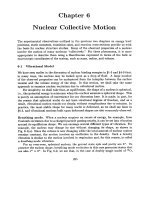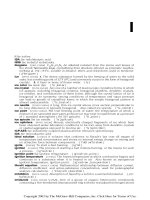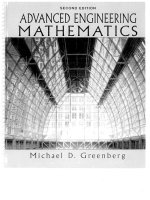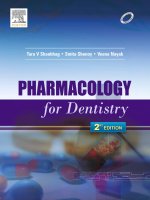Ebook Clinical electrophysiology review (2nd edition): Part 2
Bạn đang xem bản rút gọn của tài liệu. Xem và tải ngay bản đầy đủ của tài liệu tại đây (33.91 MB, 257 trang )
Chapter 4
Narrow QRS Tachycardia
133
This page intentionally left blank
Figure 4–1A
A 35-year-old woman with a history of palpitations and supraventricular
tachycardia was noted to be in this rhythm after catheters were placed
NARROW QRS TACHYCARDIA
in her heart. A maneuver was performed to identify the mechanism of
tachycardia. Has this helped?
135
Figure 4–1B
Explanation:
This is a relatively slow supraventricular tachycardia with a His electrogram preceding each QRS complex (HBED lead). The cycle length
of tachycardia varied slightly from 726 to 735 milliseconds. The differential diagnosis includes an automatic junctional rhythm, slow–fast
AV node reentry, or an atrial tachycardia with anterograde conduction
over a slow pathway. The very short VA interval excludes AV reentry. A premature atrial complex is introduced at a time when the His
bundle electrogram has already been activated and results in a shortening of the subsequent H–H interval to 657 milliseconds. There should
be no change in the subsequent H–H interval if the mechanism is an
automatic junctional rhythm because the junction would have already
136
discharged and therefore the premature atrial complex could not have
affected the subsequent cycle length. The shortening of the H–H interval is consistent with slow–fast AV node reentry in which the premature atrial complex engages a slow pathway earlier than anticipated
and affects the next H–H interval. It could have also prolonged the next
H–H interval and that would have still supported this diagnosis. Can
one totally rule out an atrial tachycardia with conduction over a slow
pathway? Note that the His to high rate interval remains constant even
though the H–H interval changes, a finding consistent with AV node
reentry but not atrial tachycardia. Indeed, this patient had relatively
slow AV node reentry that was successfully ablated at a site around the
coronary sinus ostium.
CHAPTER 4
Figure 4–2A
A 59-year-old woman underwent electrophysiologic evaluation for
recurrent episodes of tachycardia. She had known right bundle branch
NARROW QRS TACHYCARDIA
block. Explain how initiation of tachycardia occurs, the most likely
mechanism for it, and the tachycardia diagnosis.
137
Figure 4–2B
Explanation:
A single atrial premature stimulus is introduced at 340 milliseconds
during an atrial paced cycle length of 500 milliseconds. The premature
complex conducts over the AV node and induces a short VA interval
tachycardia that is most consistent with AV node reentry. This mode of
induction is referred to as a two-for-one response and seems to break
the laws of initiation for a reentrant circuit. In other words, a single
premature complex is conducted over both the fast and slow AV nodal
pathways to initiate tachycardia.
Classical teaching of reentry proposes three requisites to form the
circuit: two pathways of conduction, initial block in one pathway, and
slowing of conduction in the second pathway to allow reexcitation of
the initial blocked pathway and subsequent reentry. In this example,
138
there is no block in either pathway since the premature atrial complex conducts anterogradely over both. This “breaking of the rules” is
best explained by the inability of the initial fast pathway conduction
to conceal retrogradely into the slow pathway, which thereby allows
the slow pathway to conduct in an anterograde manner and start tachycardia. In all cases we have studied like this, slow–fast AV node reentry can always be induced during premature ventricular stimulation or
incremental ventricular pacing, consistent with essentially minimal to
no retrograde conduction into the slow pathway. This is shown with a
premature ventricular complex initiating the same tachycardia in this
patient at another point in this study. The successful ablation site was
just anterior to the coronary sinus ostium and not substantively different from the usual site one selects for patients with AV node reentry.
CHAPTER 4
Figure 4–3A
A 29-year-old man with a history of paroxysmal SVT (PSVT) undergoes
electrophysiologic evaluation. During programmed atrial stimulation in
NARROW QRS TACHYCARDIA
the control state, a premature atrial complex could only induce a few
beats of tachycardia. What is the diagnosis?
139
Figure 4–3B
Explanation:
As discussed in Chapter 1, it is always important to look for “wobble”
or changes in intervals during tachycardia and these usually occur
at the initiation or termination of tachycardia. This patient has some
key observations that prove the mechanism of at least these two echo
complexes. The accompanying figure shows an initial prolonged HV
interval of 98 milliseconds followed by a shortening to 58 milliseconds. The HA interval on the first echo complex is 254 milliseconds
and this shortens to 218 milliseconds as the HV interval shortens. The
140
change in HV predicts the change in HA. The only supraventricular
tachycardia that utilizes both the His–Purkinje system and ventricle
in the circuit is AV reentry, and that is the diagnosis. Also note that
termination of these echo complexes occurs with an atrial electrogram
without conduction to the His bundle, which was a consistent finding and strongly suggests an AV node–dependent mechanism. Indeed,
during isoproterenol infusion tachycardia persisted and ablation was
successful.
CHAPTER 4
Figure 4–4A
A 46-year-old woman with a history of recurrent palpitations undergoes an electrophysiologic study. This simultaneous 12-lead electrocardiogram was recorded in the electrophysiology laboratory prior to the
NARROW QRS TACHYCARDIA
insertion of catheters. Do you think this patient will have AV reentry as
the cause of her palpitations?
141
Figure 4–4B
Explanation:
This tracing demands careful measurement before coming to a conclusion. It also reminds us of the famous Shakespearean quote, “all that
glitters is not gold.” At first glance it appears the patient may have
2:1 conduction over an accessory pathway. One of the hallmarks of
an AV pathway, which is the typical accessory pathway, is a short PR
interval that remains constant assuming there is no change of the site
of origin of the P wave. Note that there is an apparent short PR interval
142
associated with the wide QRS complexes. Importantly, the “PR interval” is not constant and this is clearly seen in the last two wide QRS
complexes on this tracing. In essence, this is a “fooler” and is really a
series of critically timed premature ventricular complexes that happen
to be late in timing, in essence, “R on P waves.” The accompanying
figure shows that these wide QRS complexes are PVCs. Indeed, this
patient had PVCs and nonsustained VT that occurred in the presence of
isoproterenol and no evidence of an accessory pathway.
CHAPTER 4
Figure 4–5A
A 72-year-old gentleman has had nearly incessant tachycardia for the
past 6 months and the following tracing occurred at electrophysiologic
study. What is the diagnosis?
NARROW QRS TACHYCARDIA
143
Figure 4–5B
Explanation:
This is an extremely unusual variant of a much more common problem, slow–fast AV node reentry, which is rarely incessant. Typically,
tachycardia starts with a premature atrial complex, infrequently with a
PVC, and will terminate suddenly and not spontaneously reoccur. This
patient typically showed Wenckebach conduction block over the fast
AV nodal pathway until a critical AH interval occurred that allowed
tachycardia to be initiated. Tachycardia would spontaneously terminate only to restart with another Wenckebach sequence. On occasion,
as noted in the accompanying figure, during the Wenckebach sequence
a PAC would occur, and here the AH interval increases from 168 to
270 milliseconds at which time reentry occurred with a relatively short
HA interval. The tachycardia cycle length is 306 milliseconds and even
144
though there are variable AH intervals at the start of tachycardia, the
HA interval remains nearly constant, consistent with AV node dependence, ruling out atrial tachycardia as a mechanism. The VA interval is
short but not short enough to eliminate conclusively AV reentry, which
was excluded at electrophysiologic study.
As you prepare to ablate the slow pathway, you might wonder
whether the patient will have repetitive sequences of Wenckebach
block after elimination of slow pathway conduction. However, in such
situations what usually happens is 1:1 conduction over the fast pathway after elimination of slow pathway conduction. The presumption
is that electrotonic interaction occurs between the two AV nodal pathways and with elimination of the slow pathway the fast pathway can
now maintain 1:1 conduction, which was what occurred in this patient.
CHAPTER 4
Figure 4–6A
The patient has a narrow QRS tachycardia induced and ventricular
pacing has begun to entrain the tachycardia. What has happened?
NARROW QRS TACHYCARDIA
145
Figure 4–6B
It is interesting to speculate how this transition occurred. Why
did the retrograde AV node pathway suddenly appear when the AP
blocked, to start its own tachycardia? It is possible that the each QRS
was resulting in both retrograde AP and retrograde AVN conduction
but the AP was always “beating” the AVN to the atrium and the latter was not manifest. With block in the AP, the retrograde AVN pathway could now capture the atrium and drive its own tachycardia. One
may think of this as the faster AVRT “entraining” the slightly slower
potential AVNRT until block occurred in the AP, that is, analogous to
termination of “overdrive pacing” from the atrial insertion of the left
lateral AP.
It is also possible that onset of AVNRT was merely coincidental
with the cessation of AVRT, although it is somewhat difficult to explain
why there is immediate retrograde conduction over the AV node with
the next cycle.
Explanation:
The tracing starts with a narrow QRS tachycardia with a 1:1 AV relationship. The atrial activation is “eccentric,” that is, earliest in the distal
coronary sinus. This can only be AVRT over a left lateral AP or an
atrial tachycardia from the left atrium. The VA relationship stays constant in the few cycles seen, consistent with AVRT but not ruling out an
AT, and AVRT was proved elsewhere in the study. A sudden change in
atrial activation occurs after the asterisk, with prolongation of the AA
interval and a total change in the atrial activation sequence to a central
pattern. The subsequent QRS is also reset (CL 380 milliseconds from
370 milliseconds).
The differential diagnosis includes AVRT using a septal AP for retrograde conduction with a longer VA interval, AVNRT, and even AT.
AVNRT was subsequently diagnosed. The pacing spikes are distracting but do not capture until the seventh cycle and even then the pacing
is too slow to overtake the tachycardia.
146
CHAPTER 4
Figure 4–7A
SVT is induced during positioning of a multipolar catheter along the
crista terminalis in the right atrium. Adenosine is given and termination is observed. What can be concluded about the mechanism of
tachycardia?
NARROW QRS TACHYCARDIA
147
Figure 4–7B
Explanation:
Earliest atrial activation is observed in the right atrium near the HB
region. The coronary sinus is activated from proximal to distal.
The multipolar right atrial catheter and the coronary sinus cover a
relatively large part of the atria and atrial electrograms cover a rather
narrow band of the cardiac cycle (vertical lines). This is most compatible with a focal source rather than macroreentry during which the
electrograms would fill more of the cardiac cycle.
The tachycardia terminates with a QRS complex. The last several
complexes have a His recorded on the HIS d tracing and there is no
148
preceding AH prolongation, which would usually be expected with
termination of a junctional-dependent tachycardia, and slowing of the
atrial cycle length precedes termination. Prolongation of conduction in
a slowly conducting AV nodal or accessory retrograde pathway cannot
be entirely excluded from this tracing alone.
This tracing is most compatible with an adenosine-sensitive atrial
focus near the His bundle region and this is where it was ultimately
mapped and ablated.
CHAPTER 4
Figure 4–8A
This tachycardia can be described as narrow QRS with a one to one AV
relationship. Overdrive ventricular pacing is begun. Can the mechanism of tachycardia be determined from this tracing?
NARROW QRS TACHYCARDIA
149
Figure 4–8B
Explanation:
The figure shows onset of ventricular pacing during tachycardia.
Ventricular capture is evident only after the fourth spike with the fourth
QRS complex. This QRS obviously reflects fusion between the tachycardia QRS and the fully paced QRS. The subsequent atrial activation
is advanced. This is the equivalent of the PVC programmed into the
tachycardia cycle at a time when the His is refractory, that is, the “His
refractory” PVC. It is not necessary to see the His deflection since
the fused complex clearly derives in part from anterograde conduction
150
over the His, which then must be refractory. Note also that the stimulus
to A interval of the fused beat is almost the same as the VA interval of
tachycardia, proving that the pacing stimulus is activating the atrium
by the same route as during tachycardia, that is, the pacing catheter
is “in” the circuit. This is analogous to comparing these two intervals
after cessation of pacing with entrainment. Refer to Fig. 1–3 and consider how all this reflects good access of the pacing site to a sizable
excitable gap.
CHAPTER 4
Figure 4–9A
Overdrive ventricular pacing during supraventricular tachycardia. How
does one interpret this result?
NARROW QRS TACHYCARDIA
151
Figure 4–9B
Explanation:
not conduct to the first but to the second atrial electrogram. This is
then a “V A V” response. Another clue to relating the V to the correct
A is that the VA during pacing should not be shorter than the VA during tachycardia and this alone would eliminate the shorter VA during
pacing as the correct one.
At this point, one notes that the postpacing interval (PPI) at the RV
apex is 165 milliseconds longer than the tachycardia cycle length and
the change in VA between pacing and tachycardia is 180 milliseconds
(i.e., 450–270). The usual published maximum PPI to be considered
“in” the circuit for AV reentry over a septal AP is 115 milliseconds and
the corresponding delta VA is 85 milliseconds; so one can consider that
the pacing site is “out” of the circuit.
This is often loosely expressed as an “AV nodal” response but this
can be misleading since other factors (free wall AP, decremental septal
AP) can result in this type of response. It is more accurate to say that
one has excluded a “conventional” or nondecremental septal accessory pathway as the retrograde limb of the circuit. In this case it was
AVNRT.
This is a classical “entrainment” maneuver. The atrial activation
sequence during tachycardia is central and might be an atrial tachycardia, AV node reentry, or AV reentry over a septal accessory pathway.
At first glance, termination of pacing suggests a “V A A V” response
diagnostic of an atrial tachycardia but this is not the case.
The maneuver is best interpreted with a checklist approach. Pacing
should be done as close as possible to the tachycardia cycle length to
minimize potential decremental conduction, which could confound the
interpretation.
The first priority is to verify that the tachycardia has been accelerated to the pacing cycle length in a stable fashion. This is indeed the
case here, that is, 340 milliseconds.
The second step is to identify the last entrained atrial electrogram.
In this case it is indicated by the asterisk and it is the last atrial deflection at the paced CL. It is now apparent that the V during pacing does
152
CHAPTER 4
Figure 4–10A
What can be said of the mechanism of this tachycardia?
NARROW QRS TACHYCARDIA
153
Figure 4–10B
Explanation:
The tachycardia is regular with a one to one AV relationship. The atrial
activation shows earliest depolarization at CS 7,8, which is slightly in
from the orifice of the CS. This is not an anterior septal pattern and is
most likely either atrial tachycardia or atrioventricular reentry. AVNRT
is technically possible with this pattern but would be more unusual.
154
A PAC with a different activation pattern is seen (asterisk) and
delays the next cycle. This delayed cycle nonetheless has the same HA
interval as the tachycardia (the A appears “linked” to the previous H)
and this would be extremely fortuitous with an atrial tachycardia but
expected with AVRT, which it was.
CHAPTER 4
Figure 4–11A
The patient is a young woman with paroxysmal tachycardia. Tachycardia
is initiated by a critically timed atrial extrastimulus. What is the differential diagnosis and probable mechanism of the tachycardia?
NARROW QRS TACHYCARDIA
155
Figure 4–11B
Explanation:
The differential diagnosis of a narrow QRS tachycardia is presented
in Table 1–5. The tachycardia has a normal QRS, a cycle length of
320 milliseconds, and a 1:1 AV relationship. The atrial activation is
central with earliest activation at the His (arrow) where atrial activation precedes ventricular activation. This excludes sinus node reentry.
156
The short VA interval rules out AV reentry. Although atrial tachycardia
is not excluded, the apparent requirement of AH prolongation at the
onset of tachycardia makes AV node reentry most likely. Maneuvers to
assess AV node participation in tachycardia such as carotid sinus massage will confirm the diagnosis.
CHAPTER 4
Figure 4–12A
Same patient as in Fig. 4–11. There has been a sudden increase in the
tachycardia cycle length to 420 milliseconds (transition not recorded,
His catheter out of position). What is the mechanism?
NARROW QRS TACHYCARDIA
157









